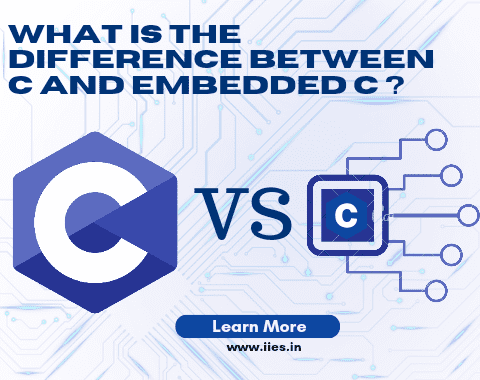
The high-level programming language C is frequently used to create embedded systems, system software, and application software. It is a powerful language that provides low-level access to computer memory and hardware.
On the other hand, embedded C is a variety of the C language created especially for creating embedded systems. Embedded systems are computer systems that are designed to perform a specific task and are embedded in other devices such as cars, appliances, and medical devices.
In this blog, we will explore the differences between C and Embedded C, their applications, uses, and disadvantages.
C language is a high-level programming language that was developed in the 1970s by Dennis Ritchie at Bell Labs. It is a general-purpose language that is widely used for developing system software, application software, and games. C language provides low-level access to computer memory and hardware, making it a powerful language for developing efficient and high-performance software. It is a structured language that supports modular programming, which makes it easy to maintain and modify code.
C language is widely used for developing system software such as operating systems, device drivers, and compilers. It is also used for developing application software such as databases, word processors, and spreadsheets. C language is popular among game developers because of its ability to handle complex graphics and sound. It is also used for developing embedded systems such as medical devices, automotive systems, and industrial control systems.
One of the major disadvantages of C language is its complexity. C language requires a deep understanding of computer hardware and memory management, which can make it difficult for beginners to learn. Another disadvantage of C language is its lack of built-in support for object-oriented programming, which can make it difficult to write large and complex software systems.
C language variation created expressly for creating embedded systems is called embedded C. Embedded systems are computer systems that are designed to perform a specific task and are embedded in other devices such as cars, appliances, and medical devices. Embedded C provides low-level access to computer memory and hardware, making it a powerful language for developing efficient and high-performance software for embedded systems.
Embedded C is widely used for developing embedded systems such as medical devices, automotive systems, and industrial control systems. It is also used for developing consumer electronics such as smartphones, tablets, and smart home devices. Embedded C is popular among developers because of its ability to handle real-time tasks and its low memory footprint.
One of the major disadvantages of Embedded C is its lack of portability. Embedded C code is often written specifically for a particular hardware platform, which can make it difficult to port to other platforms. Another disadvantage of Embedded C is its complexity. Embedded C requires a deep understanding of computer hardware and memory management, which can make it difficult for beginners to learn.
The primary distinction between C and Embedded C is what each is used for. C language is a general-purpose language that is used for developing a wide range of software applications, while Embedded C is a variant of the C language that is specifically designed for developing embedded systems. Embedded C provides low-level access to computer memory and hardware, making it a powerful language for developing efficient and high-performance software for embedded systems.
Another difference between C and Embedded C is their syntax. Embedded C includes additional keywords and syntax that are specific to embedded systems, such as interrupt service routines and memory-mapped I/O. C language, on the other hand, does not include these keywords and syntax.
In conclusion, C language and Embedded C are both powerful programming languages that are widely used for developing software applications and embedded systems. C language is a general-purpose language that provides low-level access to computer memory and hardware, while Embedded C is a variant of the C language that is specifically designed for developing embedded systems. Both languages have their advantages and disadvantages, and the choice between them depends on the specific requirements of the project.
Indian Institute of Embedded Systems – IIES